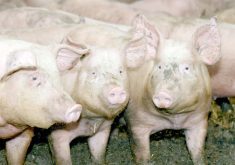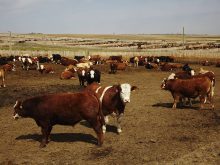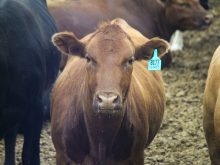ROCKY MOUNTAIN HOUSE, Alta. – Alberta livestock producers will receive a second government payment early next year, but only if they age verify this year’s calf crop and register their farms by Dec. 31.
Assistant deputy agriculture minister John Knapp said the payment is included in the producer’s income for the year but not in the information used for reference margins, which means it won’t be clawed back under the agriculture income stability fund.
As with the first payment, the second cheque is based on the average number of opening and closing 2006 inventory, multiplied by a feed proxy for the specific animal type, which uses animal type, weight gain and barley feed cost. Funding is based on feed consumed.
Read Also

Lending policy still focused on primary producers: Farm Credit Canada
Farm Credit Canada said it has not changed its business practices and remains committed to supporting all producers, after a report from an Ottawa-based media outlet claimed otherwise.
All livestock producers must register their farm with the premises identification program (PID) to receive benefits under the Alberta Farm Recovery Plan.
Forms are available through the agriculture department, Alberta Financial Services Corp. (AFSC) and the Alberta Livestock and Meat Agency’s website at www.alma.alberta.ca.
All livestock is eligible.
To speed the processing of applications, producers are asked to ensure their PID forms include their AFSC identification number, which they received in the mail with the forms.
Canadian Cattle Identification Agency account identification is also required. Producers who do not know this number or do not have one should contact the agency.
Knapp told producers at a recent meeting in Rocky Mountain House that they will receive a two page form that provides their name, address, land co-ordinates, premises number, animal species and maximum capacity of the farm.
The strategy is designed to rebuild the flagging livestock industry. Cattle numbers have dropped seven percent and hog inventories 16 percent from where they were a year ago.
“Things aren’t great in the cow-calf sector and they are even worse in the hog sector,” Knapp said.
“More people are working off the farm to support their habit of feeding 300 cows.”
If the money losing trend continues, small businesses and farm communities will struggle, he added. The province can also expect to see more business failures on farms and feedlots if livestock strategies do not change.
The strategy aims to provide more scientific research into genetic improvement, increase the number of diagnostic labs and improve the province’s ability to enter new or lost markets.
To open up trade in other countries, Knapp said the province is pushing mandatory age verification and on-farm food safety programs to give customers what they want.
“I do not think we are doing a good enough job opening those trade doors,” he said.
Knapp said proof that cattle are younger than 21 months should open more opportunities in high value markets such as Japan.
“Packers can do certain things but they need a steady supply of age verified animals for a three to four day kill,” he said.
These programs are no guarantee the industry will turn around soon, he said.
“I will not stand here and say to you that you will make more money,” Knapp said, adding producers must comply if they hope to stay in business and gain what was lost in recent years.
“If you trust government to devise a system that will make you profitable, you are going the wrong way.”















